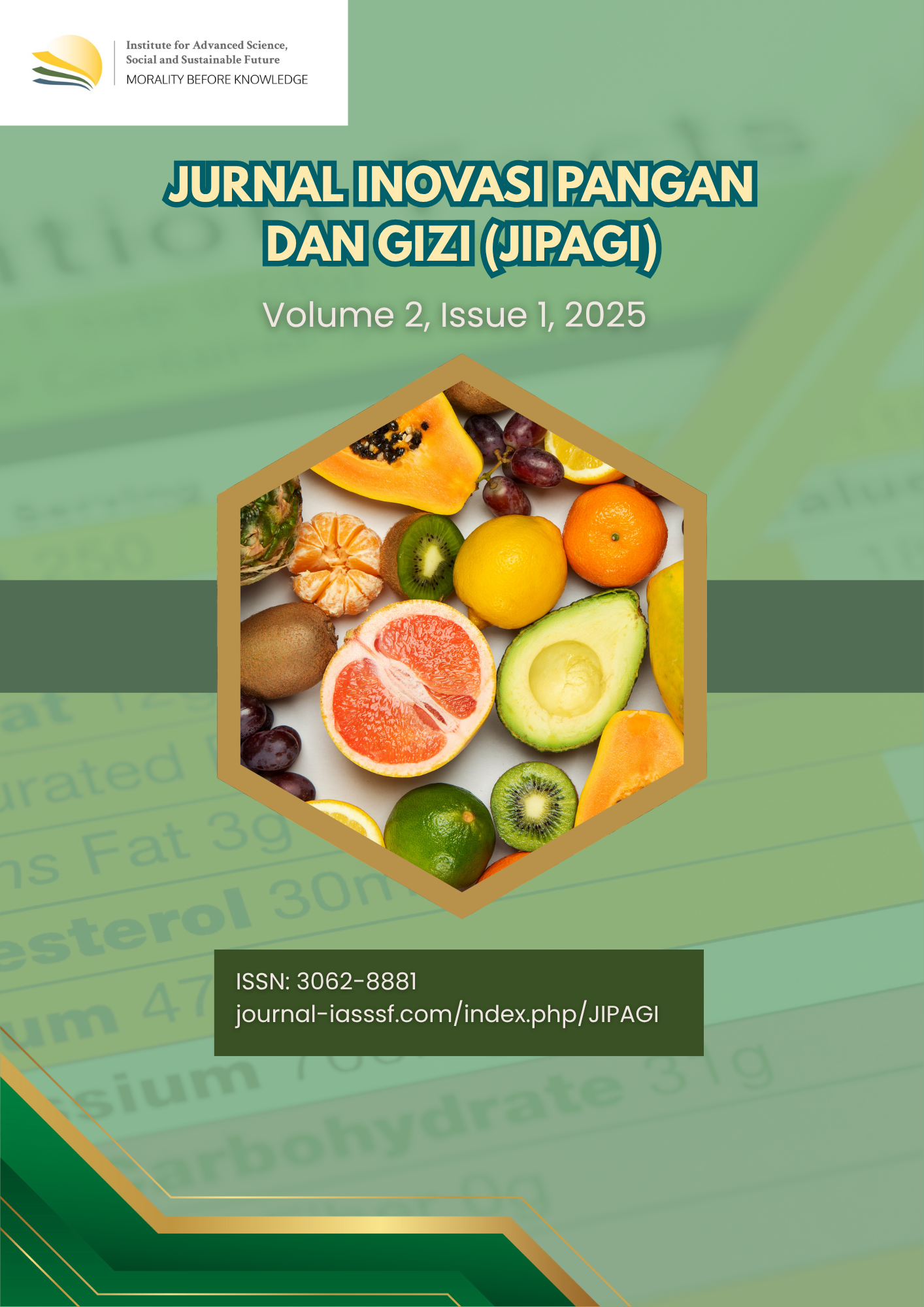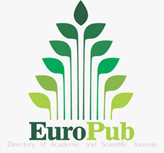Immunomodulatory effects of yogurt as a functional food: Enhancing innate immunity against influenza virus infection through in vivo analysis
DOI:
https://doi.org/10.61511/jipagi.v2i1.1772Keywords:
functional food, immunomodulator, yoghurtAbstract
Background: Influenza is a severe respiratory illness that affects people practically everywhere and is brought on by influenza viruses. Although vaccination is often used to prevent influenza virus infection, it is not always effective due to the fast rate of viral mutagenesis and the annual shift in the dominant virus strains. Boosting nonspecific innate immunity is another method of preventing influenza virus infection by strengthening natural defenses. Yogurt and other fermented functional foods have been shown to contribute to health maintenance. Methods: The objective of this review of these studies is to investigate and comprehend the in vivo approach to testing yogurt—a functional food—as an immunomodulator, particularly in influenza infection. Findings: Because extracellular polysaccharides in yogurt influence the immune system and provide protection against IAV infection, it does have immunomodulatory qualities. Yogurt eating on a daily basis before to infection significantly enhanced the survival rate of mice, the cytokine response in the lungs, and NK cell activity. It has been demonstrated that the ingredients in yogurt cause mice's splenocytes to produce more IFN-γ. Conclusion: Yogurt supplemented with nF1 has preventive and protective effects against IAV infection and can trigger immune responses by enhancing NK cell activity. Novelty/Originality of This Study: The novelty of this study lies in its exploration of yogurt as a functional immunomodulator, highlighting its role in enhancing innate immunity and providing protection against influenza virus infection through in vivo analysis.
References
Alimentarius, C. (2010). Codex standard for fermented milks. Codex Stan, 243.
Arimori, Y., Nakamura, R., Hirose, Y., Murosaki, S., Yamamoto, Y., Shidara, O., Ichikawa, H., & Yoshikai, Y. (2012). Daily intake of heat-killed Lactobacillus plantarum L-137 enhances type I interferon production in healthy humans and pigs. Immunopharmacology and immunotoxicology, 34(6), 937-943. https://doi.org/10.3109/08923973.2012.672425
Bodot V., & Soustre, Y (Eds.). (2013). Best of 2013: “Yogurt” special. Scientific and Technical Affairs Division of CNIEL aimed at professionals in the dairy industry. https://www.yogurtinnutrition.com/wp-content/uploads/2014/02/EXE-EN_BofYogurt.pdf
CDC. (2018). Evidence of HIV Treatment and Viral Suppression in Preventing the Sexual Transmission of HIV. CDC. https://www.cdc.gov/hiv/risk/art/evidence-of-hiv-treatment.html
Chava, S., Bugide, S., Gupta, R., & Wajapeyee, N. (2020). Measurement of natural killer cell-mediated cytotoxicity and migration in the context of hepatic tumor cells. Journal of visualized experiments: JoVE, (156), 10-3791. https://doi.org/10.3791/60714.
Choi, D. W., Jung, S. Y., Kang, J., Nam, Y. D., Lim, S. I., Kim, K. T., & Shin, H. S. (2018). Immune-enhancing effect of nanometric Lactobacillus plantarum nF1 (nLp-nF1) in a mouse model of cyclophosphamide-induced immuno suppression. https://doi.org/10.4014/jmb.1709.09024
Cormier, H., Thifault, É., Garneau, V., Tremblay, A., Drapeau, V., Pérusse, L., & Vohl, M. C. (2016). Association between yogurt consumption, dietary patterns, and cardio-metabolic risk factors. European journal of nutrition, 55, 577-587. https://doi.org/10.1007/s00394-015-0878-1.
El-Abbadi, N. H., Dao, M. C., & Meydani, S. N. (2014). Yogurt: role in healthy and active aging. The American journal of clinical nutrition, 99(5), 1263S-1270S. https://doi.org/10.3945/ajcn.113.073957
Fisberg, M., & Machado, R. (2015). History of yogurt and current patterns of consumption. Nutrition reviews, 73(1), 4-7. https://doi.org/10.1093/nutrit/nuv020
Harata, G., He, F., Hiruta, N., Kawase, M., Kubota, A., Hiramatsu, M., & Yausi, H. (2010). Intranasal administration of Lactobacillus rhamnosus GG protects mice from H1N1 influenza virus infection by regulating respiratory immune responses. Letters in applied microbiology, 50(6), 597-602. https://doi.org/10.1111/j.1472-765X.2010.02844.x
Ishikawa, H., Ino, S., Sasaki, H., Fukui, T., Kohda, C., & Tanaka, K. (2016). The protective effects of intranasal administration of IL‐12 given before influenza virus infection and the negative effects of IL‐12 treatment given after viral infection. Journal of Medical Virology, 88(9), 1487-1496. https://doi.org/10.1002/jmv.24494
Jun, S. H., Warner, B. A., & Murakami, K. S. (2013). RNA polymerase reaction in bacteria. In Encyclopedia of Biological Chemistry: Second Edition (pp. 167-172). Elsevier Inc. https://doi.org/10.1016/B978-0-12-378630-2.00629-0
Kawahara, T., Takahashi, T., Oishi, K., Tanaka, H., Masuda, M., Takahashi, S., Takano, M., Kawakami, T., Fukushima, K., Kanazawa, H., & Suzuki, T. (2015). Consecutive oral administration of Bifidobacterium longum MM‐2 improves the defense system against influenza virus infection by enhancing natural killer cell activity in a murine model. Microbiology and immunology, 59(1), 1-12. https://doi.org/10.1111/1348-0421.12210
Kikuchi, R., Nakamura, K., MacLauchlan, S., Ngo, D. T. M., Shimizu, I., Fuster, J. J., Katanasaka, Y., Yoshida, S., Qiu, Y., Yamaguchi, T. P., Masushita, T., Murohara, T., Gokce, N., Bates, D. O., Hamburg, N. M., & Walsh, K. (2014). An antiangiogenic isoform of VEGF-A contributes to impaired vascularization in peripheral artery disease. Nature medicine, 20(12), 1464-1471. https://doi.org/10.1038/nm.3703
Kim DaHyun, K. D., Chung, W. C., Chun, S. H., Han, J. H., Song, M. J., & Lee, K. W. (2018). Enhancing the natural killer cell activity and anti-influenza effect of heat-treated Lactobacillus plantarum nF1-fortified yogurt in mice. Journal of Dairy Science, 101(12), 10675-10684. https://doi.org/10.3168/jds.2018-15137
Kiyohara, H., Ichino, C., Kawamura, Y., Nagai, T., Sato, N., & Yamada, H. (2012). Patchouli alcohol: in vitro direct anti-influenza virus sesquiterpene in Pogostemon cablin Benth. Journal of Natural Medicines, 66, 55-61. https://doi.org/10.1007/s11418-011-0550-x
Kreijtz, J. H. C. M., Fouchier, R. A. M., & Rimmelzwaan, G. F. (2011). Immune responses to influenza virus infection. Virus research, 162(1-2), 19-30. https://doi.org/10.1016/j.virusres.2011.09.022
Li, Q., Zhang, F., Chen, G., Chen, Y., Zhang, W., Mao, G., Zhao, T., Zhang, M., Yang, L., & Wu, X. (2018). Purification, characterization and immunomodulatory activity of a novel polysaccharide from Grifola frondosa. International Journal of Biological Macromolecules, 111, 1293-1303. https://doi.org/10.1016/j.ijbiomac.2018.01.090
Livak, K. J., & Schmittgen, T. D. (2001). Analysis of relative gene expression data using real-time quantitative PCR and the 2− ΔΔCT method. Methods, 25(4), 402-408. https://doi.org/10.1006/meth.2001.1262
Makino, S., Sato, A., Goto, A., Nakamura, M., Ogawa, M., Chiba, Y., Hemmi, J., Kano, H., Takeda, K., Okumura, K., & Asami, Y. (2016). Enhanced natural killer cell activation by exopolysaccharides derived from yogurt fermented with Lactobacillus delbrueckii ssp. bulgaricus OLL1073R-1. Journal of Dairy Science, 99(2), 915-923. https://doi.org/10.3168/jds.2015-10376
Meng, H., Lee, Y., Ba, Z., Peng, J., Lin, J., Boyer, A. S., Fleming, J. A., Furumoto, E. J., & Rogers, C. J. (2016). Consumption of Bifidobacterium animalis subsp. lactis BB‐12 impacts upper respiratory tract infection and the function of NK and T cells in healthy adults. Molecular nutrition & food research, 60(5), 1161-1171. https://doi.org/10.1002/mnfr.201500665
Nagai, T., Makino, S., Ikegami, S., Itoh, H., & Yamada, H. (2011). Effects of oral administration of yogurt fermented with Lactobacillus delbrueckii ssp. bulgaricus OLL1073R-1 and its exopolysaccharides against influenza virus infection in mice. International immunopharmacology, 11(12), 2246-2250. https://doi.org/10.1016/j.intimp.2011.09.012
Nagai, T., Shimizu, Y., Shirahata, T., Sunazuka, T., Kiyohara, H., Ōmura, S., & Yamada, H. (2010). Oral adjuvant activity for nasal influenza vaccines caused by combination of two trihydroxy fatty acid stereoisomers from the tuber of Pinellia ternata. International immunopharmacology, 10(6), 655-661. https://doi.org/10.1016/j.intimp.2010.03.004
Nishimura, M., Ohkawara, T., Tetsuka, K., Kawasaki, Y., Nakagawa, R., Satoh, H., Sato, Y., & Nishihira, J. (2016). Effects of yogurt containing Lactobacillus plantarum HOKKAIDO on immune function and stress markers. Journal of traditional and complementary medicine, 6(3), 275-280. https://doi.org/10.1016/j.jtcme.2015.07.003
Nishimura, Y., Kumagai-Takei, N., Lee, S., Matsuzaki, H., Yoshiotme, K., & Otsuki, T. (2017). A new method to determine natural killer cell activity without target cells. Natural Killer Cells, 18, 1-197. https://www.intechopen.com/chapters/57507
Payne, S. (2017). Methods to study viruses. Viruses, 37. https://doi.org/10.1016/B978-0-12-803109-4.00004-0
Ryu, W. S. (2016). Diagnosis and methods. Molecular virology of human pathogenic viruses, 47. https://doi.org/10.1016/B978-0-12-800838-6.00004-7
Sanders, R., Mason, D. J., Foy, C. A., & Huggett, J. F. (2014). Considerations for accurate gene expression measurement by reverse transcription quantitative PCR when analysing clinical samples. Analytical and bioanalytical chemistry, 406, 6471-6483. https://doi.org/10.1007/s00216-014-7857-x
Schultz-Cherry, S. (2014). Role of NK cells in influenza infection. Influenza Pathogenesis and Control-Volume II, 109-120. https://doi.org/10.1007/82_2014_403
Shida, K., Sato, T., Iizuka, R., Hoshi, R., Watanabe, O., Igarashi, T., Miyazaki, K., Nanno, M., & Ishikawa, F. (2017). Daily intake of fermented milk with Lactobacillus casei strain Shirota reduces the incidence and duration of upper respiratory tract infections in healthy middle-aged office workers. European journal of nutrition, 56, 45-53. https://doi.org/10.1007/s00394-015-1056-1
Sun, C., Xu, J., Huang, Q., Huang, M., Wen, H., Zhang, C., Wang, J., Song, J., Zheng, M., Sun, H., Wei, H., Xiao, W., Sun, R., & Tian, Z. (2017). High NKG2A expression contributes to NK cell exhaustion and predicts a poor prognosis of patients with liver cancer. Oncoimmunology, 6(1), e1264562. https://doi.org/10.1080/2162402X.2016.1264562
Taubenberger, J. K., & Morens, D. M. (2010). Influenza: the once and future pandemic. Public health reports, 125(3), 15-26. https://doi.org/10.1177/00333549101250s305
Vaillant, A. A. J., Jamal, Z., Patel, P., & Ramphul, K. (2023). Immunoglobulin. StatPearls Publishing. https://www.ncbi.nlm.nih.gov/books/NBK513460/
Van Ostaijen-Ten Dam, M. M., Prins, H. J., Boerman, G. H., Vervat, C., Pende, D., Putter, H., Arjan, L., van Tol, M. J. D., Zwaginga, J. J., Schilman, M. W., & Schilham, M. W. (2016). Preparation of cytokine-activated NK cells for use in adoptive cell therapy in cancer patients: protocol optimization and therapeutic potential. Journal of Immunotherapy, 39(2), 90-100. https://doi.org/10.1097/CJI.0000000000000110
Verma, A. S., & Singh, A. (Eds.). (2013). Animal biotechnology: models in discovery and translation. Academic Press.
Vidal, S. M., Khakoo, S. I., & Biron, C. A. (2011). Natural killer cell responses during viral infections: flexibility and conditioning of innate immunity by experience. Current opinion in virology, 1(6), 497-512. https://doi.org/10.1016/j.coviro.2011.10.017
Wang, H., Livingston, K. A., Fox, C. S., Meigs, J. B., & Jacques, P. F. (2013). Yogurt consumption is associated with better diet quality and metabolic profile in American men and women. Nutrition Research, 33(1), 18-26. https://doi.org/10.1016/j.nutres.2012.11.009
Wehner, R., Dietze, K., Bachmann, M., & Schmitz, M. (2011). The bidirectional crosstalk between human dendritic cells and natural killer cells. Journal of innate immunity, 3(3), 258-263. https://doi.org/10.1159/000323923
Yu, S. L., Xu, L. T., Qi, Q., Geng, Y. W., Chen, H., Meng, Z. Q., Wang, P., & Chen, Z. (2017). Serum lactate dehydrogenase predicts prognosis and correlates with systemic inflammatory response in patients with advanced pancreatic cancer after gemcitabine-based chemotherapy. Scientific reports, 7(1), 45194. https://doi.org/10.1038/srep45194
Zhu, Y., Wang, H., Hollis, J. H., & Jacques, P. F. (2015). The associations between yogurt consumption, diet quality, and metabolic profiles in children in the USA. European journal of nutrition, 54, 543-550. https://doi.org/10.1007/s00394-014-0735-7
Downloads
Published
How to Cite
Issue
Section
Citation Check
License
Copyright (c) 2025 Dwiarti Rachma Nuramalia

This work is licensed under a Creative Commons Attribution 4.0 International License.















